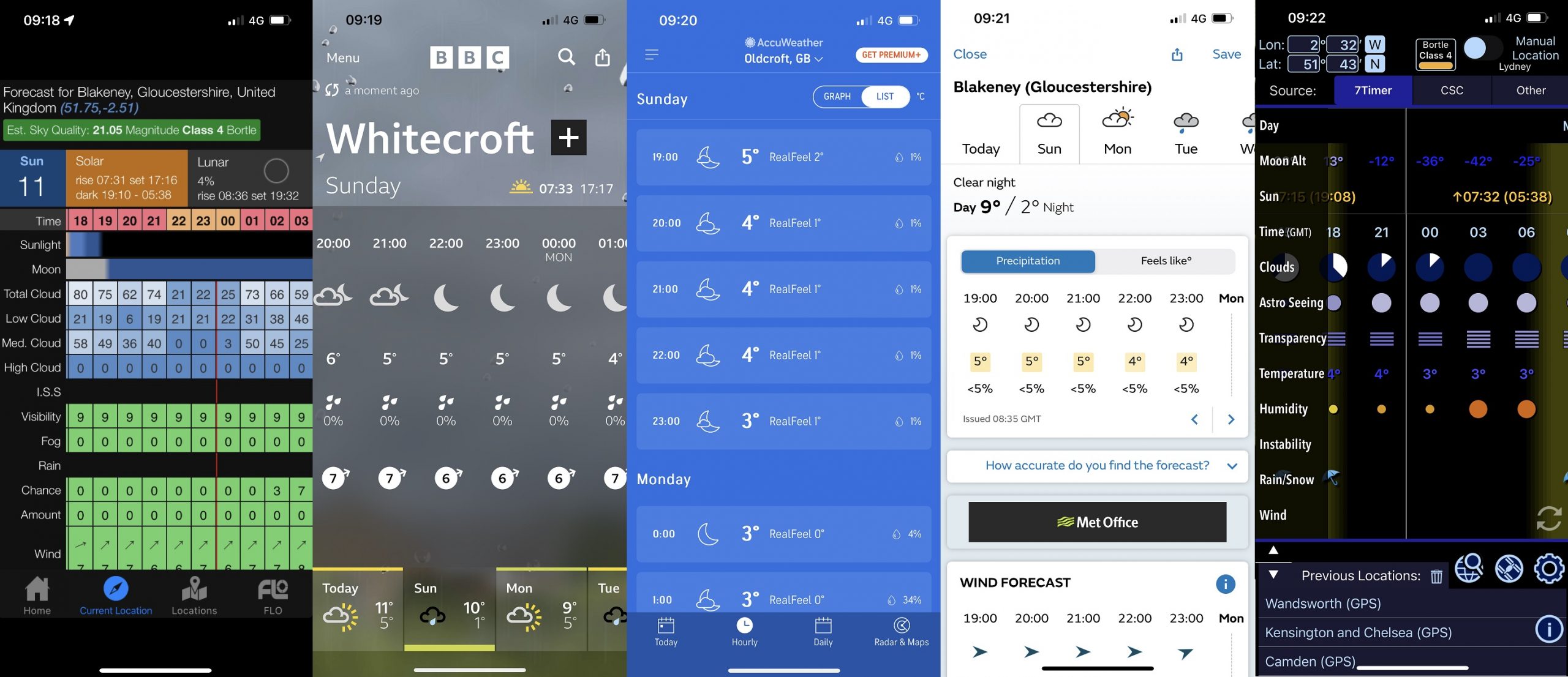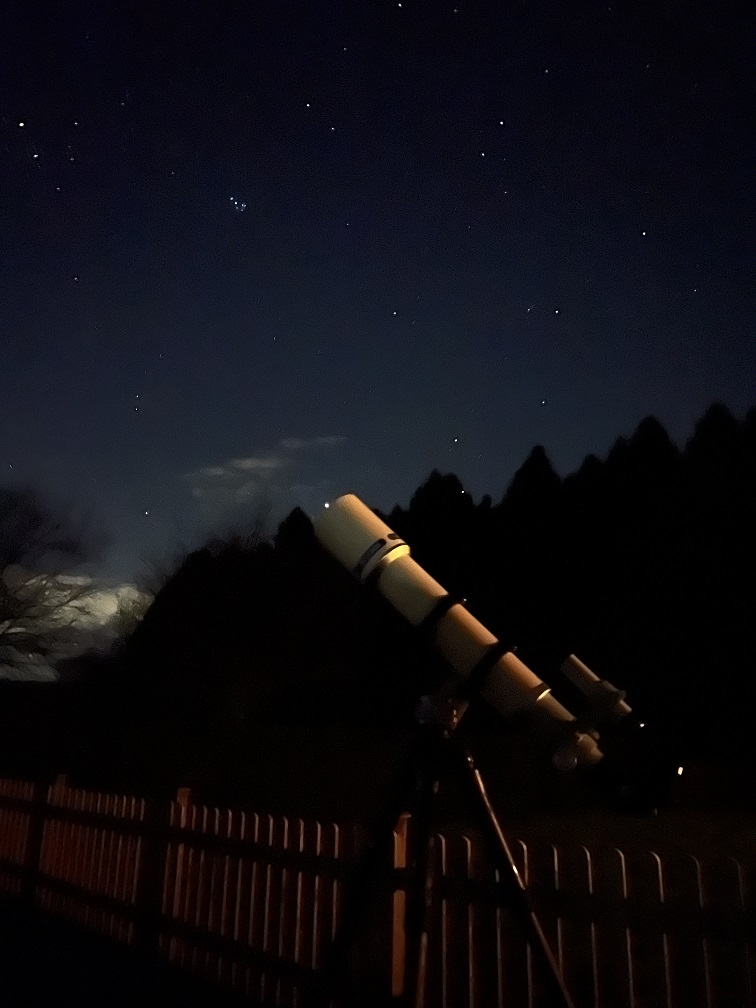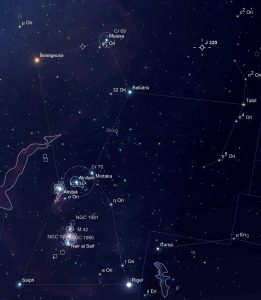With half term approaching, a few vacation days rolled over from 2023 and a requirement to use them in the first quarter of 2024, the hunt was on for something to do. The previous year we rented a lovely house in the picturesque village of Chipping Campden in the Cotswolds which slept 10, though there were only three of us plus an amazing private chef we hired to look after all our culinary needs over the 3-night stay. We decided a repeat would be a good idea but where to go this time?
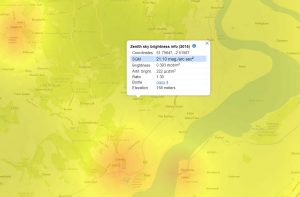
The light pollution map data suggested a dark sky. More recent data still states Bortle 4 but around 20.90 sky brightness. Click for larger image. Source: Lightpollutionmap.info
After some searching online, we selected a 6-bedroom property in the Hamlet of Oldcroft in Gloucestershire, bordering the Forest of Dean and located about 3.5km north of Lydney and 22km southwest of Gloucester. Once again, we would be rattling around in there but with a 10-metre indoor heated pool (and a 3-year who has really found her water wings with weekly lessons at nursery) and a large garden with swings, slides, a trampoline and a Wendy House, it had all we were looking for a long weekend away. Once again, we hired Philippa Davis to serve us some amazing food (so much for the post-Christmas diet!).
I could not help but notice that our weekend away would coincide with the New Moon and Lightpollutionmap.info suggested that the location was Bortle Class 4. While the forecast in the week running up to the trip was not showing cloudless skies, Sunday showed some potential and combined with dark skies that would eclipse my usual Bortle 9 Central London location, that was all the reason I needed to squeeze my Takahashi FC-100DC, the new Sightron Alt Az mount and a number of eyepieces into the car.
Fortune favours the prepared, and my faith in UK weather forecasts (dumb luck more like) was rewarded on Sunday evening with virtually cloudless skies which vastly exceeded the predictions of the half dozen weather forecasts I checked daily in the run up to departure.
While there was a small light dome from Lydney to the southwest, nothing else was particularly noticeable and the Milky Way arched overhead with many DSOs drawing the naked eye such as M44, the Double Cluster and the Andromeda Galaxy so the location seemed to deliver on the Bortle 4 classification. However, very local light pollution was a bigger issue. There were two lampposts on the road adjacent to the house though fortunately you could position yourself to block the direct impact of those lights in the garden, but also the pool house and dining pavilion had external lights on timers which only switched off at 10pm. Fortunately, those were behind me as I concentrated on the winter constellations to the south from 7pm at the onset of astronomical darkness until the timer did me a favour at 10pm.
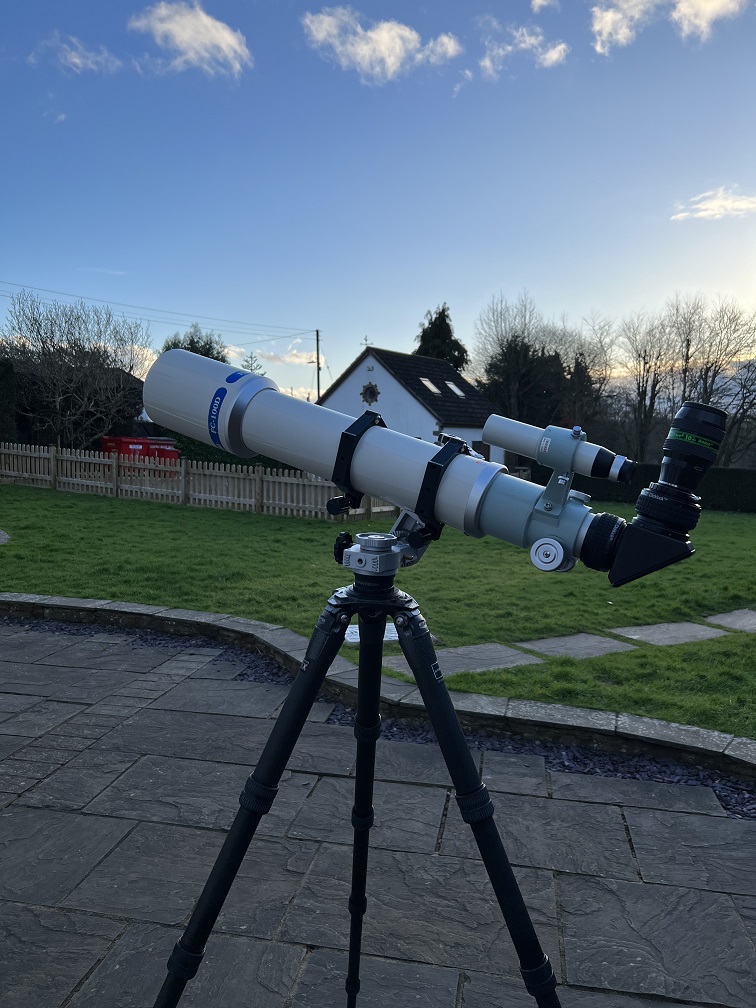
I set up the Takahashi during the late afternoon, aligning the finderscope using a distant telephone pole.
I did come somewhat prepared with a rather long hit list of DSOs divided by constellation in an attempt to focus my stargazing to be as efficient as possible in case my prayers to the cloud gods only gave a temporary reprieve from the almost omnipresent grey in the week leading up to the trip.
First up was the charging bull, Taurus and I started with number 1 in Messier’s catalogue. Often a ghostly apparition, I decided to spend a few minutes with this one to try and tease out some additional detail. The midsection appeared slightly compressed, almost like the crab had over tightened a belt around its waist and right on the limited of averted vision I felt was detecting traces of some structure within the usually featureless glow.
Moving on from a dead star, the next several objects were at the youthful end of the astronomical generation scale. I dropped back down towards the “V” shaped face of the nemesis of the matador to find NGC 1647, a pretty large open cluster about 3.5-degrees from Aldebaran. It was a fairly round cluster with two 9th magnitude stars dominating the view, with several slightly dimmer stars radiating out in spirals from the centre.

Canapes of Quail Scotch Eggs and Smoked Trout, Soy, Corriander and Ginger Crostata served with French 75 cocktails. A warm up before a 4-course meal on Saturday evening.
My next target, NGC 1746, located about 1-degree southwest from 5.5 magnitude star 103 Tauri, shouldn’t actually have an NGC designation at all. A misidentification and confusion among such luminaries as Heschel, d’Arrest, and Dreyer has resulted in two more NGC open clusters (1750 and 1758) being superimposed on top of 1746 and adjacent to each other. Studies conducted in the last 20 years showed that 1750 and 1758 are two independent clusters, but 1746 isn’t a cluster at all! The best view was with the 13mm Ethos (1.7o) which showed a Y shaped collection of stars along one side of the “cluster” with two distinct circlets of stars around it.
Known in some quarters as the “Poor man’s double cluster,” my next two marks, NGC 1807 and 1817 are easy to locate at the very top star of Orion’s shield. Though 1807 has the brighter integrated magnitude, it is far sparser with only about two dozen stars, whereas 1817 has countless faint stars. Using the 10mm Delos nicely framed both clusters with 1807 showing two “L” shaped asterisms whereas 1817 reminded me a little of Caroline’s Rose in its shape and structure.
The next DSO was just a stone’s throw west from the poor man’s double cluster, though at more than 3.5-deg in diameter, it is considered a binocular cluster and slightly exceeded the largest field I could muster with the 31mm Nagler. Collinder 65 was a sparse cluster of around 50 stars with a rather prominent equilateral triangle near the centre of 110, 111, and 113 Tau with deep orange 117 Tau just to the side of the triangle.
I decided to finished my journey around Taurus with the closest Messier object to Earth (a good pub quiz question), M45. I used the 31mm Nagler and its 3.3o field to compress the cluster and give plenty of surrounding dark space which I think create a better aesthetic for the Pleiades. Some of the icy blue-grey reflection nebula was on show with NGC 1435, better known as the Merope Nebula particularly obvious. Some delicately structured nebulosity drew my eye around the stars Sterope, Maia and Taygeta as well.
I was about move on from Taurus when I realised there was one open cluster which is spectacularly obvious but vastly exceeds even the cavernous field provided by the Nagler 31mm. At only 147 lightyears away, the Hyades subtends 330 arcminutes so this was to be a naked eye view until I suddenly thought to use the fantastic Takahashi 6x30mm finder with its 8.0o field and optics I would be happy with in an actual telescope (it’s that good). It was a lovely sight with the distinctive “V” overlaying countless cluster members while the eye was drawn to intense orange Aldebaran.
Next, I hopped over the border to Orion. It might be an old friend at this point and likely my most viewed telescopic DSO and certainly my first, but I could not resist a visit to M42. To take in the entire complex of M42/43 and NGC 1981/1975, I started with the 31mm Nagler before dropping down to 1.7o field of the 13mm Ethos. The field was ablaze with delicate green hued nebulosity with the trapezium burning away at the centre. The two wings peeled away before folding back in to envelop the glowing gas that fills the view with two open clusters at opposite sides of the field.
How many of us are guilty of heading to Orion to be wowed by glowing nebulae but ignore all the other treasures located in its borders? Even worse, we have all looked at the next DSO and not even realised! Collinder 70 includes the 3 belt stars (Alnitak is up for some debate) which means I was able to frame the entire cluster with the 31mm Nagler. The cluster includes 80-100 stars and I traced out a long chain-like snake of stars which seemed to weave around the belt stars.
I read about NGC1662, an open cluster that sits near the edge of my finder field by placing Tabit (the brightest star in the shield) on the crosshairs in a constellation guide in Sky and Telescope many years ago which referred to it as the Klingon Battle Cruiser Cluster. Being a bit of Trekkie I always remembered it because of that. However, I see a little celestial giraffe with its sets of legs and body and a long neck and head traced out by about a dozen of the brightest cluster members.
As I was in the neighbourhood, I also took a quick look at NGC 1663 which is about 2o further north from NGC 1662. Perhaps it is more impressive in larger scopes, but there was not much on offer for my 100mm refractor. A small, sparse cluster with only a few obvious members.
In the weeks leading up to the trip I found some time to read up on a few objects off the beaten path and one of them was Jonckheere 320 (yeah me neither). It is a small planetary nebula which apparently responds well to an OIII filter. Using that filter with my 31mm and placing pi1 and pi2 in the shield of Orion near the western field stop put the stellar remanent near the other edge. While looking stellar at such low magnification, I was then able to centre it and switch to the 7mm Nagler. At this power it showed a small disc. I would love to try this one with a larger aperture scope to see what details can be teased out of it.
Happy I was able to find my last target, even if it did not give much at the eyepiece with a 4” scope, I headed back towards the shoulder of Orion (no, there were no attack ships on fire) and Bellatrix. Just a degree northeast is small Dolidze 17. Some literature refers to as an asterism, and others as an open cluster. Definitely better compressed, I used the 13mm Ethos to tighten up its 10-arcminute diameter which is made of just 5 stars which form three sides of a rectangle.
Three objects in row I had not seen before in Orion? I certainly was going to give it a go with NGC 1788, a reflection nebula but much easier found starting at Cursa (Beta Eridani). Placing Cursa on the southern edge of the 31mm put my target almost dead centre. It appeared a slightly fuzzy star which expanded when using averted vision. Increasing the magnification to 57x with the 13mm and continuing to use averted vision showed the brightest area around what appeared to be dim star and knot of faint light on the opposite edge of the elongated axis. Taking the power higher lessened what I was able to glimpse so I decided to move on.

The impressive 10 metre pool was housed in a separate building adjacent to the main house. We had a lot of fun in there during the days.
Feeling the need for a bit more of showpiece after a few “ticked that off the list objects,” I galloped over to Monoceros for the Rosette Nebula. This object always makes me chuckle when I think about how many NGC objects are associated with it (another good astro pub quiz question). NGC 2237, 2238, 2239, 2244, and 2246. Placing would-be supernova Betelgeuse in the northern part of my 31mm, it was simple 9o pan to run straight into the obvious, very boxy cluster that lies at the heart of the nebula. I actually passed over Collider 92 on my way, but spend no more than a few seconds studying this small open cluster before continuing on. The main stars of the cluster made me think of the way a child might draw a house, peppered with random arrangement of fainter stars. The nebula itself proved somewhat elusive until I used the UHC. I kept the power low at 24x and was rewarded with a patchwork of delicate nebula encircling the cluster with a complex pattern of dark webs crisscrossing the glowing gas.
Next, I dropped down to Canis Major. Always worth a shot every time the brightest star in the sky is visible so I had a crack at splitting Sirius. However, it was immediately obvious that was not going to happen. The pup would not emerge from the pulsating mess of its 10,000x brighter companion.
A simple pan south 4-degrees led me to my next target, M41. Reportedly seen by Aristotle, though he had the advantage of a proper dark sky, I certainly could not make it out naked eye. Two comparably bright, ruddy stars immediately drew my eye before noticing a large pentagram of slightly fainter stars sitting on top of the numerous dimmer cluster members.
I rarely view M46 and M47 unless I am fortunate enough to be observing in the southern hemisphere though I am not sure why in retrospect as both had a similar altitude as Sirius, which also made it a simple pan west from the Dog star to locate them. I actually sailed over NGC 2360 (C58) on my way to the clusters. This cluster was Caroline Herschel’s first original DSO discovery and she included it on her list as No.2. I was already using the 24mm Panoptic which would nice frame both of my next targets which kept this 10’ cluster well compressed. I noted a slightly elliptical body at the centre with several arms of stars which made me think of a starfish.
My habit with these two is viewing them simultaneously,hence the 24mm Panoptic. This may also explain why I have never noticed the planetary nebula (unlikely to be a cluster member) NGC 2438 that appears to reside in M46. This time that nebula was on my see list. At that low power of 30x, M46 is a finely resolved cluster of almost countless star with a tight spiral structure. An arc of dim stars appears to emanate from the cluster edge and leads all the way to M47 forming a starlight bridge. M47 appeared smaller and less dense with stars but with a far more interesting variation in range of brightness with the brightest appearing around 6th magnitude. At this power I also squeezed in small open cluster, NGC 2423. However, it is a sparse cluster and hard to delineate from the busy background sky and I would certainly miss it if I did not know it was there.
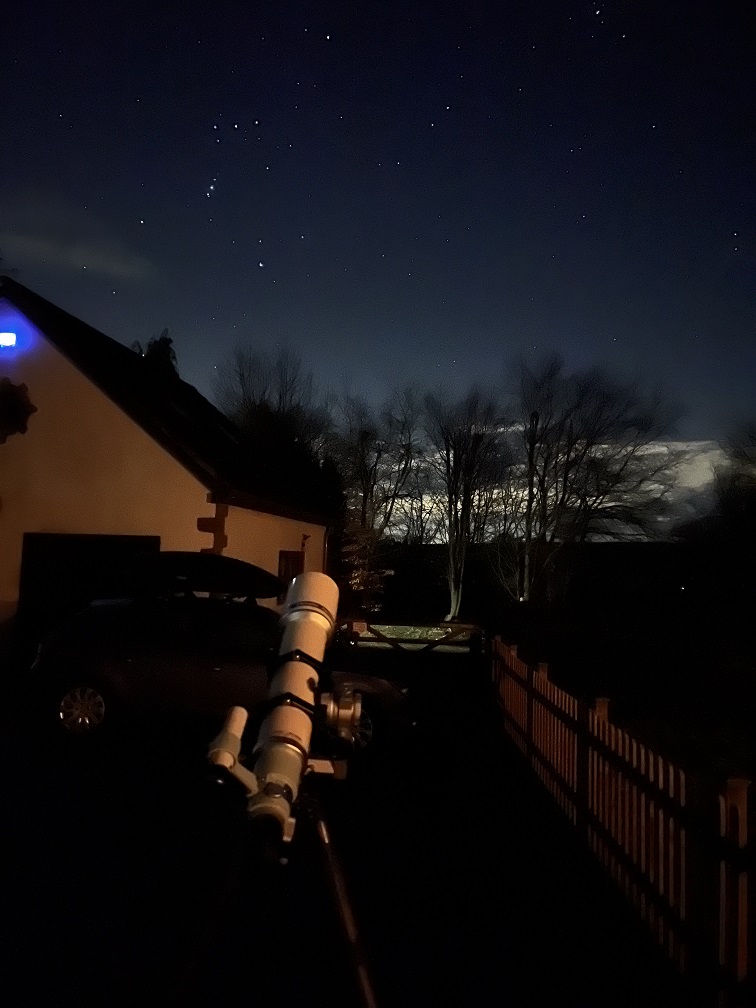
I set up in the car park next to the large garden and used the garage to block one of the nearby street lights.
Viewing M46 with averted vision at 30x I was vaguely aware that something was not quite right with one of the stars. However, upping the power to 105x with the 7mm Nagler showed this ghostly apparition. It was intensified and easier with an OIII which dimmed the stellar cluster members.
Changing course, I elevated my gaze back to two members of the crew of part of the ship Argo I had just visited, during the voyage for the golden fleece, Castor and Pollux. Gemini held several objects on my list and I started with Propus. A good test for a 3” scope, this tight double proved slightly harder than it should for the 4” Takahashi. Once again, I was the victim of the less than ideal seeing, but the magnitude 6.1 secondary gave itself up at the 4mm setting of the zoom. A slight shift N-W using the 13mm Ethos nicely framed the large open Cluster Collinder 89. The field was dominated by four, bright yellow suns, which I suspect are field stars rather than cluster members. The cluster itself appeared to have several clumps of fainter white stars with sparse, almost empty lanes dividing it along with a couple of pretty ruddy red stars in the mix.
Despite moving onto a cluster only 2/3 the size of Cr89, I stayed with the 13mm Ethos for M35. Always a showpiece object, this view of the open cluster did not disappoint. Streams of stars radiated away in all directions from a central asterism that looked a little like an infinity sign. Though I was not looking for it, I did note the hazy glow of NGC 2158, less than 30’ from the centre of M35. Far less impressive in the eyepiece, but that is only really a function of distance with both clusters sharing very similar physical characteristics. NGC 2158 just happens to reside almost six times further away.

I might be terrible at it, but I do love a game of pool which was available when not splashing around in the pool
Back to dead stars again with the next DSO and once again out with a puff rather than a bang was NGC2392 / C39, the Eskimo Nebula. Using Wasat in Gemini as a starting point and two 5th magnitude stars (56 and 63 Gem) which together form an equilateral triangle. Offsetting just slightly from the base of this triangle will bring the planetary into view in a medium power eyepiece. Using the 6mm setting of the zoom for 123x, the nebula displayed a sharp nucleus surrounded by inner shell and second, fainter outer shell. The inner shell showed hints of structure with two locations of greater intensity which I perceived as more dense material. For some reason I did not use any of my nebula filters.
I moved onto Auriga with just three classic DSOs in mind and switched to the 10mm Delos for all three. Using Theta Aurigae as a springboard to find M37 by placing it near the top edge of my finder which placed the open cluster near the field centre. M37 is an actual discovery of Messier which was somehow missed by Le Gentil when found M36 and M38 in 1749, despite both being dimmer. As always with M37, the topaz jewel that sits at the heart of the cluster beckoned my gaze, surrounded by an oval of sparkling diamonds. The dark lane which appears to cleave the cluster into two components was also quite obvious.
Moving M37 to the edge of the finder placed M36 near the centre of the finder. About 2/3 the apparent size of M37, it is somewhat overshadowed by the nearby cousin. A dozen or so stars shone in circle with a couple of streams radiating away against the feeble glow of many more cluster members. It is always interesting to remember that at a distance of more than 4,000 light years, this cluster is around 10x further than M45 and would significantly outshine the Seven Sisters with greater than three times the absolute luminosity of some 8,000 suns.
A two-degree hop away was my last target in Auriga, M38, colloquially known as the Starfish cluster. I also noted NGC 1907, a small nearby open cluster as a hazy which appeared joined to M38 by a stream of stars that pealed off the larger cluster.
The last couple of objects in Auriga were less impressive than I would have expected but did not give it too much thought. While pondering where to head next, I thought I would have another quick look at M42. “Hmm, that is a bit dim, is there a high cloud over it?” Looking up from the eyepiece, I could not see anything and the view in the finder was similarly poor. Disaster had struck! Both the finder and main objective had fogged up. There was a lot of moisture in the air, it was very cold (ice was forming on my car and eyepiece bag) and virtually no wind to keep the air moving and I had not packed any dew prevention measures with me (I am more use to my APM LZOS scopes with longer dew shields and Kruppax tubes which are almost magical in their ability to repel dew). I was not going to be beaten. I took the scope inside for it to warm up but patience was not a virtue. Never do I what I did (risk of thermal shock), but using a hair dryer on lowest setting from a distance of about three metres I gently wafted air over the objective and finder for several minutes until the fog had evaporated.
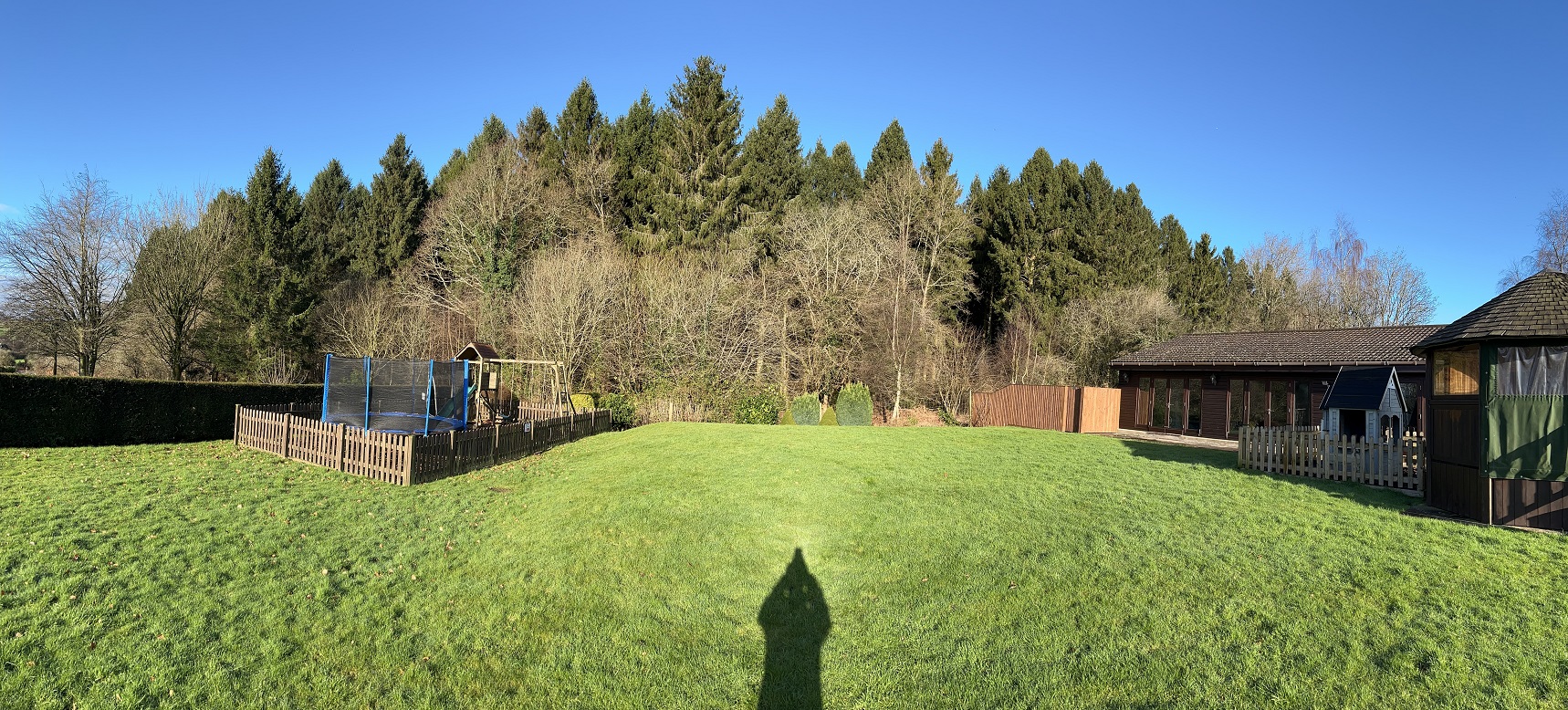
The view west of trees on the edge of the Forest of Dean which block the lower 15 to 20 degrees of the western horizon. Also shows the pool house and out door dining pavilion.
Back in business and back outside, I quickly reattached the telescope to the mount and was ready to go. Looking over my shoulder to the west, I realised that high tree line of part of the Forest of Dean would rob of an object or two on my hit list later in the night so I spun around to Andromeda, starting with my favourite colour contrasted double star, Almach. A pair of stars that seem to show almost as many hues as observers who point their telescope at it. Herschel described the pair as reddish-white primary and the fifth magnitude companion as a fine light sky blue, inclining to green. I actually see the primary as reddish-yellow white and a delicate green on the secondary using the 7mm Nagler for 106x and 0.75-deg field.
Placing Almach near the top edge of my finder put my next quarry within the field of the 31mm Nagler. A rather old open cluster at around two billion years old, NGC 752 (C28) has a large apparent diameter of some 75’ and it actually appeared to almost fill the significantly larger field of the 31mm. With no obvious central concentration and a lot of surrounding field stars, it is very hard to determine visually the true extent of the cluster. But that makes the view even more spectacular in my opinion. One could almost imagine several clusters in close proximity thanks to several groupings of stars on display. Just on the southern edge were two brighter stars, one red and the other yellow but they are unrelated field stars.
From C28, I panned the scope south to Mirach (Beta Andromedae) which I used as a launch pad for my next two targets (perhaps that should be five?). Almost a full finders field east lies M31, the Andromeda galaxy, and it two attendant satellites, M32 and M110. Staying with the 31mm to take in as much of the considerable dimension of this future Milky Way collision, the bright core immediately drew my eye along with the conspicuous dark lane running along one edge. While attempting to glimpse more detail with averted vision I felt was detecting small clumps and grains of material in the outer halo which may have been indications of DSOs within the galaxy itself.
I have rarely shown much attention to M32 and M110, the latter discovered by and featuring in Messier’s drawing of the “Great Andromeda Nebula” but for some reason not included in his catalogue until 1966 when it was added by Kenneth Glyn Jones as the final entry. This time I tried to tease out some detail. Using the 6mm setting of the Nagler Zoom (123x), the normally featureless circular glow perhaps showed a very slight concentration towards the core, but nothing more. Perhaps there is less to see. M32 has no globular clusters, which is rather unusual as M110 has 8 and M31 more than 450. Models suggest that a previous interaction with M31 likely stripped them all away. M110 proved more interesting at the same power. There was a definitely mottling to the nucleus and a dust lane on the side adjacent to M31.
Panning back to Mirach, and moving an almost identical 7o west, saw me arrive at M33, the Pinwheel Galaxy. I kept the power relatively low using the 13mm Ethos (57x). I have had much better views of this galaxy in similar sized scopes in the past and reflected the high moisture content in the air which was revealed every time I switched on my headlamp. However, the tight, small, stellar like nucleus was clear along with some hints at spiral arms. Familiarity with the galaxy, meant I knew where to look to spy M33’s largest HII region (NGC 6O4).
Of all the ecliptic constellations, Cancer has to be the most innocuous. I often struggle to spot its primary stars even under a dark sky. This was no different. However, I knew exactly where it was as M44, The Beehive Cluster was visible naked eye and I couldn’t resist a visit. While the cluster would have been nicely framed in the 13mm Ethos, my tendency to want to compress open clusters meant I used the 31mm Nagler. The field was abuzz (couldn’t resist, sorry) with stars chaotically swarming around that boxy “hive” structure in the centre of the cluster.
As I stopped in Cancer, I decided to check out M67 as well even though neither object had been on my target list. I just dropped the scope south a few degrees until the cluster appeared near the western edge of my finder and then I centred in using the 13mm. Overshadowed by its cousin to the north in terms of apparent size and brightness, once again a victim of location as it is in fact about 5x as distant and intrinsically larger. Most interestingly, it is by far the oldest open cluster to make Messier’s catalogue at 3.2-to-5 billion years old. Sometimes known as the King Cobra Cluster, I was able to understand why. The cluster has a prominent concentration of stars which seems to curve into an s-shape like the body of a snake with an almost triangular point which could be the head.
I decided to leave the confines of the Milky Way again and headed for the Leo triplet (M65, M66 and NGC 3628. I have managed M65 and M66 from Regent’s Park in central London with a 4” scope before so to say the view was underwhelming was an understatement. Both galaxies were visible but NGC 3268 was right on the limit with averted vision. Surely, I was not fogged up again? A quick inspection of the objective, finder and eyepiece said no, so what was going on? My Baader BBHS 2” mirror diagonal had somehow been taken out by the cold conditions during an eyepiece switch! This would have normally been it after my previous trip inside but rather fortuitously I had also packed my 1.25” Tele Vue Everbright diagonal. I do not normally have that level of redundancy in my equipment but I was thankful I did. The 31mm was out of commission now, so wide field would now be handled by the 24mm Panoptic (2.1o).
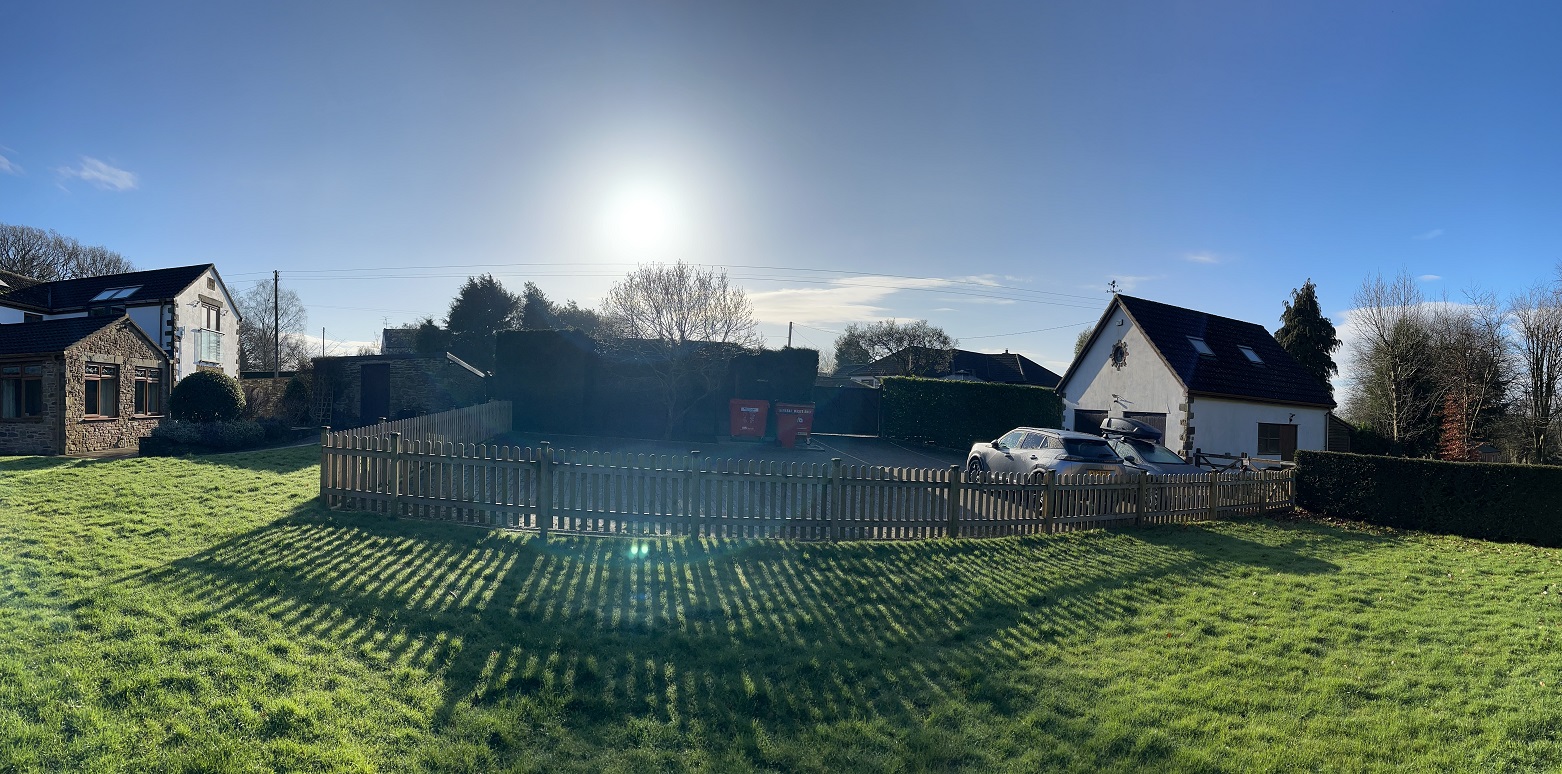
The view to the south and southeast is relatively unobstructed which was fortunate given my target list focused mostly on winter constellations towards the south.
I decided to stay extra galactic for a few more minutes. M51 was first and was an easy find three degrees east from Alkaid in Ursa Major. Even with a fresh diagonal, the high moisture content in the air had stolen much of the transparency and beyond the two cores and a very faint haze that surrounded them it is hard to perceive much detail.
Almost doubling the altitude to over 70o did improve things a little for M81 and M82. I kept it low power using the 24mm Panoptic. M81 showed some structure in the diffuse ellipse around the core which hinted at the spiral arms of this photogenic galaxy. The spindle of pale light that is M82 showed hints of mottling. Certainly not the best view I have had with a 4” class scope of this pair, but better than I expected after M51.
Sadly, with a 3-plus hour drive home in the morning the session could not run into the early hours of the morning. I decided I would finish up with some open clusters in Cassiopeia as the constellation was still sitting above the treeline.
I elected to start with NGC 1027 which sits along the boundary of the Heart Nebula. By placing Segin (Epsilon Cass) on the very edge of the 8o field of the finder put the cluster on the edge of the opposite top quadrant which then allowed me to centre in the field of the telescope. I used the 10mm Delos and my gaze immediately focused on the brightest star in the field which happens to be unrelated to the cluster. The illusion that as many as 20 cluster members are in orbit around it is compelling with several more stars dispersed further still.
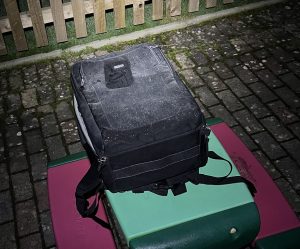
My eyepiece bag was covered in a layer of frost by the end of the 5-hour session. My car had turned into an ice cube over the same period!
Stock 2, sometimes known as the Muscleman Cluster was completely unknown to me until I decided to hunt down all the open clusters in Cassiopea brighter than Mag 12 in a post Covid lockdown staycation in 2020 (there are 44 by the way and you can read that report here). I expect I have scanned over this impressive cluster many times on my way to the Double Cluster and never even realised. I do not make that mistake anymore. This is large at 60’ but preferring to have plenty of sky around it to give better context to the boundaries, I used the 24mm Panoptic. I did not see the headless muscleman that others see, but there is clearly a box-like shape to one side of the cluster with several fainter stars dancing around it and a “V” shaped group sailing away from the main group.
Switching down to the 7mm I quickly tracked down NGC 654 which is almost equidistant between Segin and Ruchbah and just slightly offset from the imaginary line that connects them. The yellow, 7th mag star which is a cluster member provides an anchor for the small grouping which appeared to have two sections, an ellipse at 90-degrees to a “V” asterism.
Two thirds of a degree from NGC 654 is one of those how is this not a Messier object DSOs? Patrick Moore made up for this omission by including NGC 663 in his Caldwell catalogue as C10. I stayed with the 7mm which shows the core region of the cluster as three distinct regions with the unresolved light of dimmer cluster members joining them in a horseshoe with a prominent dark lane which is rather obvious by its lack of stars compared to the immediate surroundings.
There was no way I was visiting some open clusters in Cassiopeia without stopping by one of my favourites found anywhere in the heavens. NGC 457 will always be the E.T. Cluster to me, with the little stick figure with the bright eyes extending its arms for a celestial embrace.
My last target for the evening, about 3-degress directly south from Caph was NGC 7789. Caroline Herschel discovered this superb cluster in the Autumn of 1783 and now it has the idiomatic name of Caroline’s Rose. I decided to use the 13mm to compress the 30’ cluster as I find that emphasises the twisting loops of stars that appear to trace out the petals of the romantic flower. As I observed the cluster, the trail of green shooting star whizzed through the field, bisecting the rose almost as though Cupid had fired an arrow at the flower most associated with love in honour of the rapidly approaching Valentine’s Day. A rather nice, and fortuitous way to finish the session.






